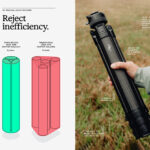Have you ever wondered what exactly a “stop” is, or why photographers gauge light that way? This video, by Joshua Cripps, makes it all too clear how to talk and measure light like a pro:
The first thing to note is that a stop is not a constant measurement, like a foot or an ounce. Instead, it’s a relative measure between two levels of brightness.
A stop is basically changing your light by a factor of two in either direction—making it twice as bright or twice as dark. In the picture below, Cripps offers three different examples of a stop:

Examples of a Stop
The middle image’s shutter speed is one second, which means the brighter one above is two seconds—a.k.a. one stop brighter. The darkest image, at the bottom, is one stop darker than the middle, meaning its exposure time is a half a second.
As Cripps puts it:
“If you increase the exposure of your photo by one stop, you’ve made it twice as bright. Or, an even better way to think about it, you’ve let in twice as much light into your camera.”
Simple, right? So whether the difference in exposure time is between 1/200 and 1/400 of a second, or four and eight seconds, both are examples of one stop.
Like This Article?
Don't Miss The Next One!
Join over 100,000 photographers of all experience levels who receive our free photography tips and articles to stay current:






Leave a Reply